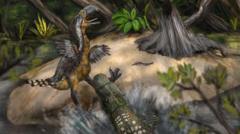In a remarkable paleontological breakthrough, scientists have discovered teeth marks on the leg bone of a terror bird that suggest it was killed by a large caiman 13 million years ago. Terror birds, towering avian reptiles known for their violent predatory skills, were significantly larger than humans, featuring robust legs and lethal hooked beaks. Palaeontologists in Colombia analyzed these teeth marks and determined they were made by a crocodile-like reptile, highlighting a fierce battle that likely led to the bird's demise.
The findings, detailed in the journal Biology Letters, compared the size and form of the teeth impressions with existing museum specimens of crocodilian predators. This research provides a rare glimpse into the dynamics between two dominant species from the same era. The leg bone was first discovered in Colombia's Tatacoa Desert over 15 years ago, where during the Middle Miocene, it existed as a humid habitat filled with swamps. This specific terror bird would have stood approximately 2.5 meters tall, using its strong legs and beak to hunt prey.
Despite the evidence of the caiman attack, researchers, led by Andres Link from the Universidad de Los Andes, could not conclusively determine if the terror bird was killed instantly in the struggle or if it was later scavenged. "There is no evidence of healing in the bite marks," explained Dr. Link, indicating that if the bird had not died already, it was likely fatally wounded in this encounter.
Fossils from the rich deposits of the Tatacoa Desert offer valuable insights into the prehistoric ecosystem, illustrating that terror birds were more susceptible to predation than previously believed. The piece of leg bone, discovered by local fossil collector César Augusto Perdomo, has forged a connection between researchers and fossil enthusiasts. The biting marks found on the bone align closely with those of the now-extinct Purussaurus neivensis, a caiman that could reach lengths of up to five meters.
Dr. Link posits the possibility that the massive predator was ambushing its prey from the water's edge, akin to modern alligators and caimans. The study not only deepens our understanding of the ancient food web but also emphasizes the significance of every fossil fragment in reconstructing the history of life on Earth.
Each archaeological find illuminates a fragment of life's past, and Dr. Link highlights how even a single bone can enrich our narrative of prehistoric existence.
The findings, detailed in the journal Biology Letters, compared the size and form of the teeth impressions with existing museum specimens of crocodilian predators. This research provides a rare glimpse into the dynamics between two dominant species from the same era. The leg bone was first discovered in Colombia's Tatacoa Desert over 15 years ago, where during the Middle Miocene, it existed as a humid habitat filled with swamps. This specific terror bird would have stood approximately 2.5 meters tall, using its strong legs and beak to hunt prey.
Despite the evidence of the caiman attack, researchers, led by Andres Link from the Universidad de Los Andes, could not conclusively determine if the terror bird was killed instantly in the struggle or if it was later scavenged. "There is no evidence of healing in the bite marks," explained Dr. Link, indicating that if the bird had not died already, it was likely fatally wounded in this encounter.
Fossils from the rich deposits of the Tatacoa Desert offer valuable insights into the prehistoric ecosystem, illustrating that terror birds were more susceptible to predation than previously believed. The piece of leg bone, discovered by local fossil collector César Augusto Perdomo, has forged a connection between researchers and fossil enthusiasts. The biting marks found on the bone align closely with those of the now-extinct Purussaurus neivensis, a caiman that could reach lengths of up to five meters.
Dr. Link posits the possibility that the massive predator was ambushing its prey from the water's edge, akin to modern alligators and caimans. The study not only deepens our understanding of the ancient food web but also emphasizes the significance of every fossil fragment in reconstructing the history of life on Earth.
Each archaeological find illuminates a fragment of life's past, and Dr. Link highlights how even a single bone can enrich our narrative of prehistoric existence.



















